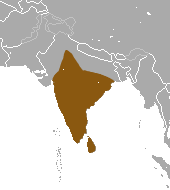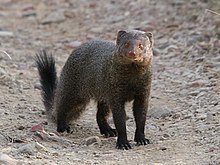Ruddy mongoose
| Ruddy mongoose | |
|---|---|
 | |
| Scientific classification | |
| Domain: | Eukaryota |
| Kingdom: | Animalia |
| Phylum: | Chordata |
| Class: | Mammalia |
| Order: | Carnivora |
| Suborder: | Feliformia |
| Family: | Herpestidae |
| Genus: | Urva |
| Species: | U. smithii |
| Binomial name | |
| Urva smithii (Gray, 1837) | |
 | |
| Ruddy mongoose range | |
| Synonyms | |
| Herpestes smithii | |
The ruddy mongoose (Urva smithii) is a mongoose species native to hill forests in India and Sri Lanka.[1]
Description[edit]
The ruddy mongoose's fur is brownish and coarse, long in hindquarters, but short in other parts of the body. Its head to body length is 40–45 cm (16–18 in) with a 36 cm (14 in) long tail. Males are larger and heavier than females with a weight of 2.2 kg (4.9 lb); females weigh about 1.2 kg (2.6 lb). Tail constitute about 75–90 % of body length. It is distinguished by the Indian grey mongoose by its slightly larger size and jet black-tipped tail.[2]
Distribution and habitat[edit]


The ruddy mongoose is mainly a forest-living animal and prefers more secluded areas. It has also been recorded in secluded paddy fields and in comparatively open fields.[3]
Taxonomy[edit]
Herpestes smithii was the scientific name proposed by John Edward Gray in 1837 for a zoological specimen in the collection of the British Museum Natural History.[4] All Asian mongooses are now thought to belong in the genus Urva.[5]
Subspecies:[6]
- U. s. smithii
- U. s. thysanurus
- U. s. zeylanius
Ecology and Behavior[edit]
It usually carries its black tipped tail tip curved upward which is visible from a distance. Like other mongooses, it hunts by day and by night,[3] and feeds on birds, rat snakes, land monitors, rodents and snails. Generally a solitary animal, rarely can be seen in pairs during mating season. However, mother and pup family groups consisting about five animals have been observed.[2]
It is found in thick jungles, forest edges near paddy fields and tea estates. However, withdraw quickly in a crevice or underneath a rock shelf during human confrontation. When cornered, they fight fearlessly with loud and shrill cries.[2]
In culture[edit]
In Sri Lanka this animal is usually regarded as an unlikable animal and a pest. The golden palm civet (Paradoxurus zeylonensis), altogether a different species endemic to Sri Lanka, is also called hotambuwa due to similar appearance and coloration.
References[edit]
- ^ a b Mudappa, D. & Choudhury, A. (2016). "Herpestes smithii". IUCN Red List of Threatened Species. 2016: e.T41617A45208195.
- ^ a b c Yapa, A.; Ratnavira, G. (2013). Mammals of Sri Lanka. Colombo: Field Ornithology Group of Sri Lanka. p. 1012. ISBN 978-955-8576-32-8.
- ^ a b Prater, S.H. (1971). The Book of Indian Animals (Third ed.). Bombay: Bombay Natural History Society. ISBN 019562169-7.
- ^ Gray, J. E. (1837). "Description of some or little known Mammalia, principally in the British Museum Collection". The Magazine of Natural History and Journal of Zoology, Botany, Mineralogy, Geology and Meteorology. I (November): 577–587.
- ^ "ASM Mammal Diversity Database". www.mammaldiversity.org. Retrieved 2021-07-08.
- ^ "Indian marsh mongoose Herpestes palustris Ghose". Archived from the original on 2003-09-08.
External links[edit]
 Data related to Herpestes smithii at Wikispecies
Data related to Herpestes smithii at Wikispecies


 French
French Deutsch
Deutsch